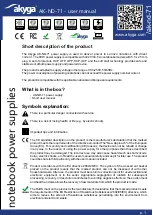
LABPS23023
V. 04 – 18/08/2016
4
©Velleman nv
5.
Overview
Refer to the illustrations on page 2 of this manual.
1
LCD: indicates the current value and the output voltage of the master.
2
LCD: indicates the current value and the output voltage of the slave.
3
Slave C.V.-adjustment: rotary switch to adjust the output voltage of the slave.
4
Slave C.C.-adjustment: rotary switch to adjust the output current of the slave (to determine the
current-limiting point)
5
Power switch: push button used to activate/deactivate the device. Either the C.V.- or the C.C.-
indicator is lit when the device is activated.
6
C.C.-mode indicator of the slave output or indicator for parallel connection: this indicator is lit when
the slave output is in the C.C.-mode or when the two adjustable outputs are connected in parallel.
7
C.V.-mode indicator of the slave output: this indicator is lit when the slave output is in the C.V.-
mode.
8
Negative binding post of the slave output: the negative pole of the output voltage is connected to the
negative terminal of the load being tested.
9
Earthing connection of the housing: the housing is grounded.
10
Positive binding post of the slave output: the positive pole of the output voltage is connected to the
positive terminal of the load being tested.
11/12
Control switches used to select independent operation, operation in parallel or in series.
13
Negative binding post of the master output: the negative pole of the output voltage is connected to
the negative terminal of the load being tested.
14
Earthing connection of the housing: the housing is grounded.
15
Positive binding post of the master output: the positive pole of the output voltage is connected to the
positive terminal of the load being tested.
16
Master output C.C.-indicator: this indicator is lit when the master output is in the C.C.-mode.
17
Master output C.V.-indicator: this indicator is lit when the master output is in the C.V.-mode.
18
Negative binding post of the fixed 5VDC-output: the negative pole of the output voltage is connected
to the negative terminal of the load being tested.
19
Positive binding post of the fixed 5VDC-output: the positive pole of the output voltage is connected
to the positive terminal of the load being tested.
20
Master output C.C.-adjustment: rotary switch used to adjust the current value of the master output
(adjustment of the current-limiting point).
21
Master output C.V.-adjustment: rotary switch used to adjust the voltage value of the master output.
6.
Operation
6.1
Independent use of the two adjustable outputs
Place switches [11] and [12] in the OFF-position.
Proceed as follows when the adjustable outputs are used as C.V.-outputs: put the C.C.-control switches [4]
and [20] in the max. position and use the power switch [5] to activate the device. Install the required DC
output voltage for both master and slave using the rotary switches for C.V.-adjustment [3] and [21]. The
C.V.-indicators [7] and [17] will light.
Proceed as follows when the adjustable outputs are used as C.C.-outputs: Use the power switch [5] to
activate the device. Put the C.V.-control switches [3] and [21] in the max. position and place the C.C.-
control switches [4] and [20] in the min. position. Connect the required load and install the required output
current by means of rotary switches [4] and [20]. The C.V.- mode indicators [7] and [17] will extinguish
and the C.C.-mode indicators [6] and [16] will light.





































